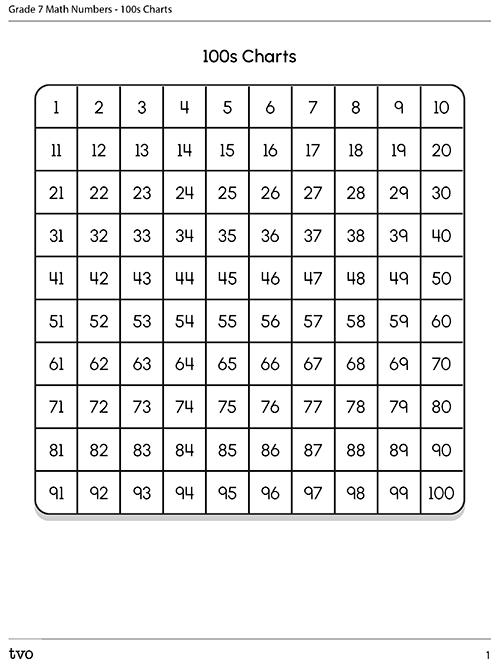Minds On
Thinking about multiplying and dividing
Explore the following statements and discuss three options with a partner or record your options in a method of your choice. Where might you come across this statement and how might you solve it? Using virtual or concrete manipulates, visual representations, or models, share your thinking.
1. Two times 3
2. of $3
3. Three quarters doubled
4. of a glass of water
5. of jugs of milk
6. $3 divided by 2
7. 3kg divided by
8. a dollar divided by 3
9. litres divided by
Action
Multipyling and dividing with fractions
Let's work with fractions of fractions! Using a 100s chart, highlight, in a method of your choice, of the chart. Using a second 100s chart highlight, in a method of your choice, . Compare the two 100s charts. How much of the area is shared by both fractions? This area is equal to
Complete the 100s Charts in your notebook or using the following fillable and printable document.
When we multiply fractions, we simply multiply the numerators together, then the denominators together.
(simplified to )
When we divide fractions, it is a little more complicated. We have to think about what it means to divide parts of a whole by parts of a whole. Let’s explore the following image:
If we are working with the question
We are asking the question, how many quarters are there in ?
This measuring cup displays and . Compare the two. Do you notice where is? Where is?
You can tell in this image that there are two s in but how do we do this mathematically?
In order to do this calculation we take the and exchange its numerator and denominator (flip it). Because we have altered this fraction to its reciprocal (exchanging the numerator and denominator) we also have to change the division to multiplication. By doing this, we then multiply the 2 numerators together and the two denominators together and then we get the answer which becomes 2 when we calculate 4 ÷ 2.
Hot cocoa mix
Bruno is responsible for the snacks and drinks for the family movie night this week. They want to serve hot cocoa with marshmallows. Help Bruno with their fractions while they prepare the drinks. Show your work.

- At the grocery store the package of hot cocoa is on sale for off the original price. If the original price is $6, what is the sale price?
- Bruno has 3 packets of the cocoa powder and a mug of drink requires a packet. How many mugs can they prepare?
- Bruno's mug was full when the family dog knocked of it onto the floor. How much was left in the mug?
- The bag of marshmallows was full and Bruno divided them evenly into 6 mugs. What fraction of the bag went in each mug?
Consolidation
Juice Bar
On Saturdays, Kalani helps their family run a Juice Bar. They are preparing juice jugs using concentrated flavours of water and sugar. They must be very careful mixing the correct quantities.
They take out the full bucket of sugar.
Kalani puts of the sugar into the Lemon Zest mix.
They then put of the sugar left into the Peach Punch.
of what is left is then used for the Orange Mixture.
They put of the sugar left into the Raspberry Juice jug.
Kalani puts half of the leftover sugar into the Lime drink.
How much of the full bucket of sugar is left?
Explain your thinking.

Reflection
As you read the following descriptions, select the one that best describes your current understanding of the learning in this activity. Press the corresponding button once you have made your choice.
I feel...
Now, expand on your ideas by recording your thoughts using a voice recorder, speech-to-text, or writing tool.
When you review your notes on this learning activity later, reflect on whether you would select a different description based on your further review of the material in this learning activity.
Press ‘Discover More’ to extend your skills.
Discover MoreThe following chart lists the number of pitchers Kalani made of each juice and the fraction of each pitcher to make a serving. Calculate how many servings of each flavour she has for the day.
| Juice Flavour | Number of pitchers made | Serving Size |
| Lemon Zest | of a pitcher | |
| Peach Punch | 3 | of a pitcher |
| Orange Mix | 6 | of a pitcher |
| Raspberry Juice | ||
| La-Lime | 1 |
Kid size servings should be smaller. How can Kalani come up with a way to calculate kid size servings?
Connect with a TVO Mathify tutor
Think of TVO Mathify as your own personalized math coach, here to support your learning at home. Press ‘TVO Mathify’ to connect with an Ontario Certified Teacher math tutor of your choice. You will need a TVO Mathify login to access this resource.
TVO Mathify (Opens in new window)